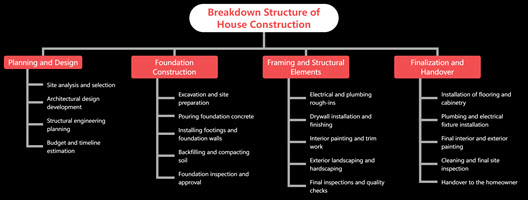Breakdown Structure Diagrams are essential tools in project management, helping to organize and visualize different aspects of a project. Here’s a brief overview of each type, along with key concepts and examples:
1. Project Management
Key Concept: This encompasses the overall framework for managing a project, integrating all components to ensure successful completion.
(Edit the Breakdown Structure Diagram Below)

2. Work Breakdown Structure (WBS)
Key Concept: A hierarchical decomposition of the total scope of work required to complete a project.
- Example 1: For a construction project, the WBS might include phases such as Design, Construction, and Inspection.
- Example 2: In software development, it could break down into Planning, Development, Testing, and Deployment.
- Example 3: An event planning WBS might consist of Venue Selection, Catering, Entertainment, and Marketing.
3. Organizational Breakdown Structure (OBS)
Key Concept: This structure outlines the project’s organizational hierarchy and assigns responsibilities.
- Example 1: In a corporate project, it may include departments like Marketing, Development, and HR.
- Example 2: For a non-profit project, it might list roles like Project Manager, Volunteers, and Board Members.
- Example 3: In a government project, it could involve various agencies involved in the project.
4. Risk Breakdown Structure (RBS)
Key Concept: A hierarchical representation of risks associated with a project, categorized by type.
- Example 1: Technical risks, such as software bugs or hardware failures.
- Example 2: Financial risks, including budget overruns or funding shortages.
- Example 3: External risks, like regulatory changes or market fluctuations.
5. Cost Breakdown Structure (CBS)
Key Concept: This structure categorizes all costs associated with a project, ensuring comprehensive budget management.
- Example 1: Direct costs, like labor and materials.
- Example 2: Indirect costs, such as overhead and administrative expenses.
- Example 3: Contingency costs, set aside for unforeseen expenses.
6. Resource Breakdown Structure (RBS)
Key Concept: A hierarchical representation of all resources needed for a project, including human, physical, and financial resources.
- Example 1: Human resources, such as team members and consultants.
- Example 2: Physical resources, including equipment and facilities.
- Example 3: Financial resources, encompassing budget allocations and funding sources.
7. Product Breakdown Structure (PBS)
Key Concept: A hierarchical structure that defines the components and sub-components of the project deliverables.
- Example 1: For a software product, this might include Frontend, Backend, and Database components.
- Example 2: In a manufacturing project, it could break down into Raw Materials, Components, and Final Assembly.
- Example 3: For an event, it may include Venue, Catering, Entertainment, and Marketing Materials.
8. Procurement Breakdown Structure (ProcBS)
Key Concept: This outlines all procurement activities and components, helping manage contracts and purchases.
- Example 1: Categories might include Equipment, Services, and Materials.
- Example 2: For a construction project, it may cover Contractors, Building Materials, and Equipment Rentals.
- Example 3: In IT projects, it could involve Software Licenses, Hardware, and Support Services.
9. Stakeholder Breakdown Structure (StakBS)
Key Concept: This identifies all stakeholders involved in the project, their interests, and influence.
- Example 1: Internal stakeholders like Project Team, Management, and Department Heads.
- Example 2: External stakeholders including Clients, Suppliers, and Regulatory Bodies.
- Example 3: Community stakeholders, such as Local Residents and Advocacy Groups.
10. Location Breakdown Structure (LocBS)
Key Concept: This categorizes the geographical aspects of a project, often critical for logistics and resource allocation.
- Example 1: Different project sites like Headquarters, Branch Offices, and Field Locations.
- Example 2: For a global project, it may include regions like North America, Europe, and Asia.
- Example 3: In an event, it could break down into Venue, Parking, and Surrounding Areas.
These breakdown structures help project managers visualize and manage various aspects of a project, ensuring thorough planning and execution. Each structure serves a unique purpose, contributing to overall project success by clarifying roles, responsibilities, risks, and resources.
Streamline Your Project Management with Visual Paradigm Smart Board!
Are you looking to enhance your project management efficiency? Discover the power of Visual Paradigm Smart Board!
Creating a Work Breakdown Structure (WBS) mind map has never been easier. With our intuitive platform, you can start by selecting from a range of templates or choose a blank canvas tailored to your project’s unique requirements.
Key Features:
- User-Friendly Interface: Effortlessly drag and drop to add main branches representing major project phases.
- Customizable Elements: Edit text, colors, and layouts for maximum clarity and impact.
- Versatile Applications: Beyond WBS mind maps, utilize Smart Board for brainstorming sessions and strategic planning.
Transform your project management approach with Visual Paradigm Smart Board, ensuring your projects are managed seamlessly from conception to completion.
Get started today and take your project management to the next level! 🌟
Breakdown Structure Templates

Breakdown Structure

Breakdown Structure for New Toy Product

Breakdown Structure of House Construction

Breakdown Structure of Online Course

Breakdown Structure of Advertising Project

Breakdown Structure of Software Development

Breakdown Structure of Market Research

Breakdown Structure of Wedding Ceremony Preparation

Breakdown Structure of Menu Planning

Breakdown Structure of Video Shooting

Breakdown Structure of Website Design
